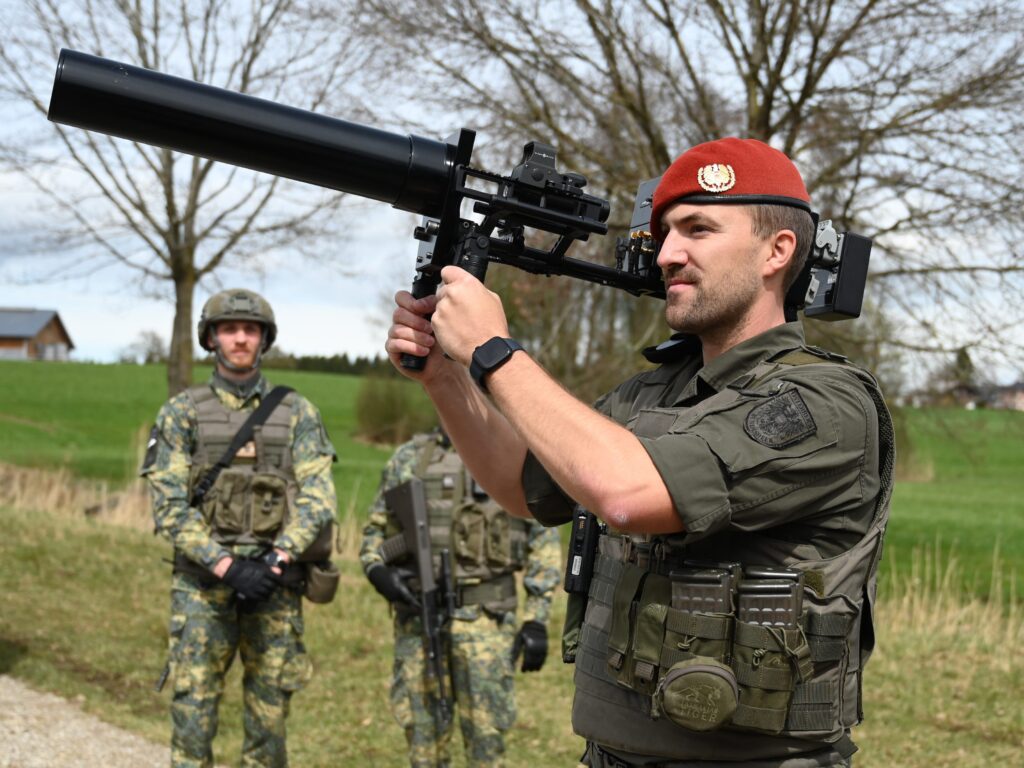
The federal government plans to advance the development of its drone defense strategy in response to recent drone incidents across Europe. The Council of Ministers adopted the corresponding resolution on Wednesday. The goal is to adapt existing and future protective measures to evolving threat scenarios. Among other initiatives, a joint forum is planned for all agencies involved in drone defense.
Defense Minister Klaudia Tanner (ÖVP) said at the presentation of the plan, approved by circular resolution, in the press briefing at the Federal Chancellery that drones are among “the greatest threats of our time.” Along with her colleagues, State Secretary Jörg Leichtfried (SPÖ) and NEOS parliamentary leader Yannick Shetty, Tanner pointed to the numerous drone incidents in Europe in recent months, especially around airports.
Leichtfried emphasized that the threats are complex and diverse, ranging from espionage and sabotage to destabilization. “No country is immune from these attacks — not even our Austria. Austria can and likely will become a target of such attacks,” he said. Critical infrastructure and easily vulnerable targets such as airports, trains, and road systems are especially at risk. “These threats are by no means abstract but concrete and severe.”
Tanner: Coordination between all agencies necessary
Austria must be protected from these threats, Tanner stressed. The Armed Forces had recognized the risks early on and had been working for several years on corresponding protection measures. The goal is to detect airspace violations by drones, assess the danger, and take countermeasures. This requires “perfect coordination” between all relevant agencies.
“That is why the Council of Ministers’ resolution is so important, as it concerns all affected ministries,” Tanner said, referring to the Interior Ministry, the Defense Ministry, and the Infrastructure Ministry — the latter being responsible for civil aviation oversight through Austro Control.
The Austrian airspace is violated about 50 to 60 times a year, Tanner stated. To gather information, there is cooperation with Austro Control. Eurofighters may then be deployed to identify and escort the intruding aircraft. For any potential shoot-down, “clear guidelines” are needed, but also proportionality, she added.
Responsibilities “relatively clear”
The responsibilities in drone defense still need to be more precisely defined, Tanner noted. Leichtfried also saw a need for action, even though everything was already “relatively clearly regulated.” When airspace violations occur, the Defense Ministry must intervene, while the Interior Ministry is primarily responsible for protection against surveillance.
International cooperation is a key aspect, Leichtfried said, pointing to “tremendous advantages” in this area. Shetty agreed, emphasizing the European perspective: “No country in Europe can defend itself alone.” Austria must therefore participate in data sharing.
When asked about the timeframe for implementing the new strategy and further details, government members were cautious. Tanner described the current circular resolution as “essentially the starting shot.” However, she noted that one must “live in a constant state of readiness.” It was “difficult to say when it will be completed,” as changes to the Security Police Act might be needed over time. “That we want to move quickly goes without saying, given the mentioned threat situations,” said Tanner.
Tanner: Making the Armed Forces the strongest army of the Second Republic
Government representatives also referred to threats from Russia and recent airspace violations at Europe’s external borders. Tanner pointed to the Armed Forces 2032+ development plan, which includes participation in the European Sky Shield Initiative (ESSI), through which missile defense systems beyond short range will be acquired.
“Our common goal — and especially mine as Minister of Defense — is to make the Austrian Armed Forces the best and strongest army of the Second Republic, so that we can face new threats such as drones. This is not done for its own sake but out of necessity,” Tanner said. The minister also referred to recent or ongoing procurements, such as the order of 36 ‘Skyranger 30’ anti-aircraft systems, which can also be used for drone defense.
Tanner also addressed long-range air defense. A corresponding financing law is currently being negotiated within the coalition, she said.
Shetty also referred to airspace violations in Europe by Russia: “Putin and his regime are waging a hybrid war,” he said. “That is exactly why we must be better prepared in Austria.”
Greens: Strategy is a ‘castle in the air’
The Greens expressed little enthusiasm for the government’s plans. “What is being presented today as a drone defense strategy is nothing more than another castle in the air,” said defense spokesperson David Stögmüller in a statement. The Greens are demanding concrete measures such as “a comprehensive risk analysis, clear legal responsibilities, and immediate technical and organizational protective measures.” They also plan to raise the issue of drone defense again in the National Council’s Interior Committee.

